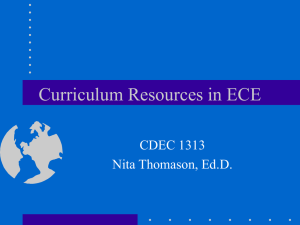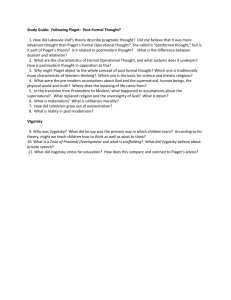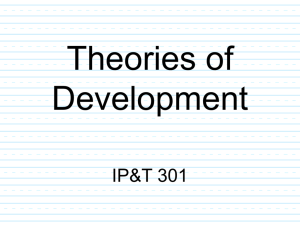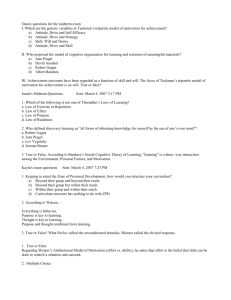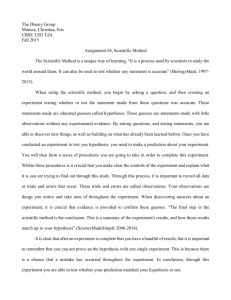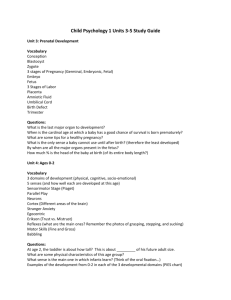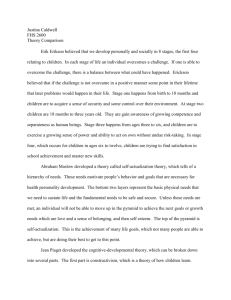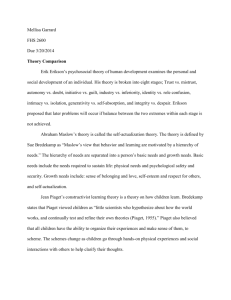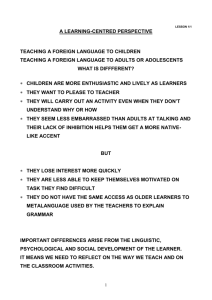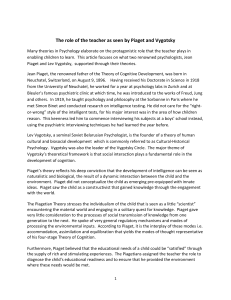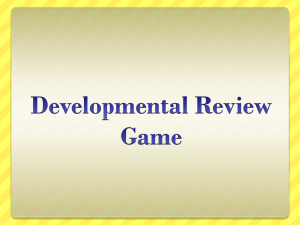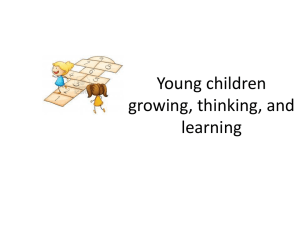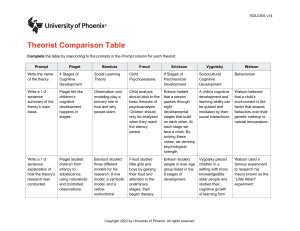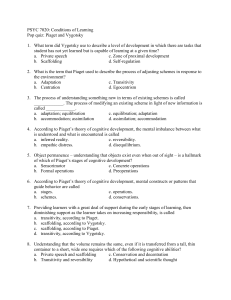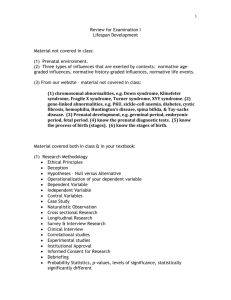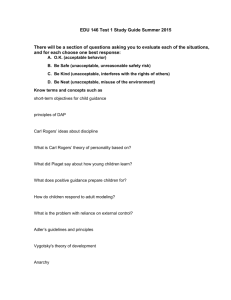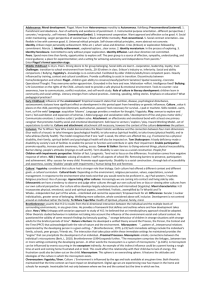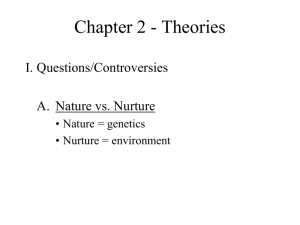Test Questions
advertisement
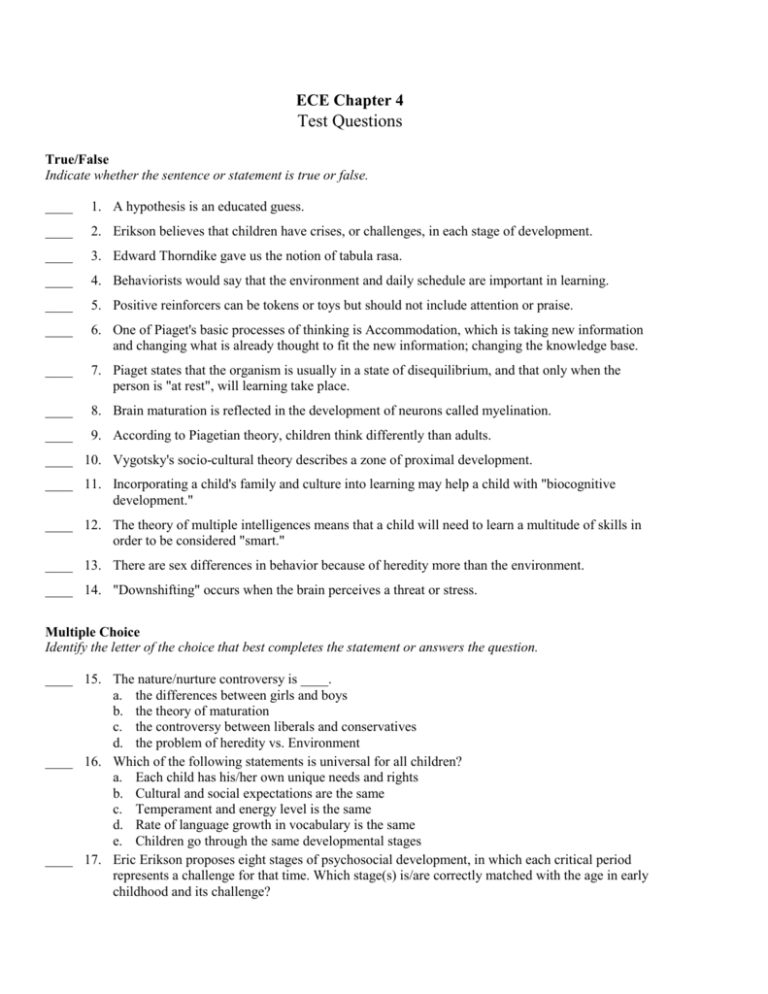
ECE Chapter 4 Test Questions True/False Indicate whether the sentence or statement is true or false. ____ 1. A hypothesis is an educated guess. ____ 2. Erikson believes that children have crises, or challenges, in each stage of development. ____ 3. Edward Thorndike gave us the notion of tabula rasa. ____ 4. Behaviorists would say that the environment and daily schedule are important in learning. ____ 5. Positive reinforcers can be tokens or toys but should not include attention or praise. ____ 6. One of Piaget's basic processes of thinking is Accommodation, which is taking new information and changing what is already thought to fit the new information; changing the knowledge base. ____ 7. Piaget states that the organism is usually in a state of disequilibrium, and that only when the person is "at rest", will learning take place. ____ 8. Brain maturation is reflected in the development of neurons called myelination. ____ 9. According to Piagetian theory, children think differently than adults. ____ 10. Vygotsky's socio-cultural theory describes a zone of proximal development. ____ 11. Incorporating a child's family and culture into learning may help a child with "biocognitive development." ____ 12. The theory of multiple intelligences means that a child will need to learn a multitude of skills in order to be considered "smart." ____ 13. There are sex differences in behavior because of heredity more than the environment. ____ 14. "Downshifting" occurs when the brain perceives a threat or stress. Multiple Choice Identify the letter of the choice that best completes the statement or answers the question. ____ 15. The nature/nurture controversy is ____. a. the differences between girls and boys b. the theory of maturation c. the controversy between liberals and conservatives d. the problem of heredity vs. Environment ____ 16. Which of the following statements is universal for all children? a. Each child has his/her own unique needs and rights b. Cultural and social expectations are the same c. Temperament and energy level is the same d. Rate of language growth in vocabulary is the same e. Children go through the same developmental stages ____ 17. Eric Erikson proposes eight stages of psychosocial development, in which each critical period represents a challenge for that time. Which stage(s) is/are correctly matched with the age in early childhood and its challenge? ____ 18. ____ 19. ____ 20. ____ 21. ____ 22. ____ 23. ____ 24. ____ 25. a. St a g e1…. . I nf a nc y …. . Compe t e n c yv s .I nf e r i o r i t y b. St a g e2…. . Tod dl e r …. . Au t o nomyv s .Sha mea ndDoubt c. St a g e3…. . Ch i l dh ood…. . Goodv s .Ev i l d. St a g e4…. . Sc hool -Ag e …. . Tr us tv s .Mi s t r us t According to Erikson's theory, the role of the adult is that of ____. a. ensuring that the child has opportunities to play b. a shaper of appropriate behaviors c. both of the above d. none of the above The behaviorists assert that the environment plays an enormous role in learning. They are ____. a. Maslow, Watson, and Piaget c. Thorndike, Skinner, and Bandura b. Watson, Thorndike, and Vygotsky d. Skinner, Bloom, and Montessori Albert Bandura, who developed the theory of social learning, reminds us that ____. a. play is important b. modeling is a primary way children learn c. an unresolved crisis can harm a child d. money is the root of all evil Piaget's three basic processes of thinking are ____. a. adaptation, accommodation, equilibration b. stimulus, response, punishment c. example, imitation, modeling d. love, belonging, esteem The socio-cultural theory of Vygotsky states ____. a. culture and language play a critical role in development b. the child need not be considered as a whole c. children think in concrete terms and cannot think things through themselves d. self-directed speech is the lowest rung of the scaffold Howard Gardner is a professor of human development who has developed ____. a. a postulate about siblings and friendship b. a theory of multiple intelligences c. the notion that actions speak louder than words d. giant ideas in the nursery school Below is a list of the hierarchy of Maslow's human needs. Which ones are basic needs? a. Safety, food, shelter, security b. Shelter, self-sufficiency, truth, aliveness c. Food, shelter, justice, respect for others d. Security, food, justice, self-sufficiency Attachment is ____. a. critical to the development of the self b. an "affectional bond" between two people c. the "dance" between a child and a favored loved one d. all of the above Completion Complete each sentence or statement. 26. In preoperational thought, children are taught to ____________________. 27. In constructivist theory, children are taught to learn mostly by adaptation, so the teacher needs to ____________________. 28. Arnold Gesell developed the ____________________, which details norms of behavior. Short Answer 29. Piaget's theory has been called both maturational and environmental; that is, that both nature and nurture are at work. Why? Give an example of each from your own experiences with children. 30. What can teachers learn from Piagetian theory? Include in your answer something about materials, scheduling, and the role of the teacher. 31. Respond in a few sentences to these basic conditions for learning. Include in your answer how programs are designed, what teachers do, and what developmental or learning theories support these conditions. a. Learning must be real. b. Learning must be rewarding. c. Learning must build on children's lives. d. Learning needs a good stage.
